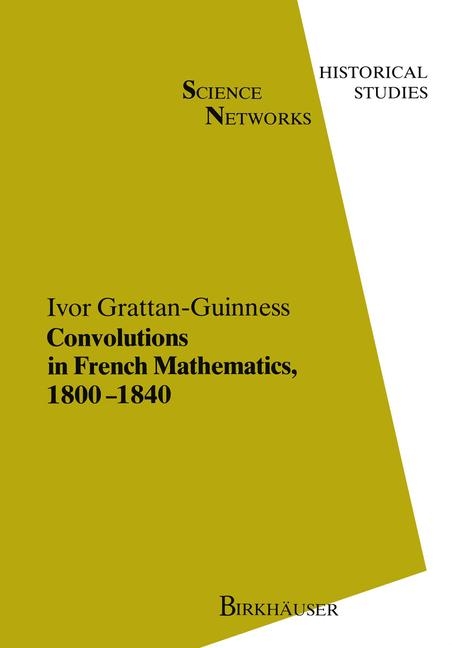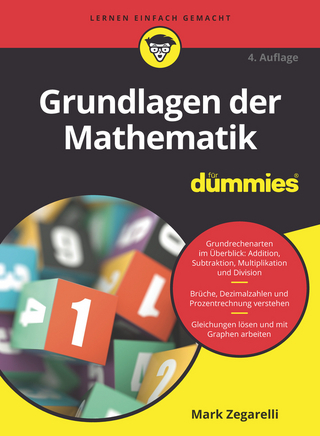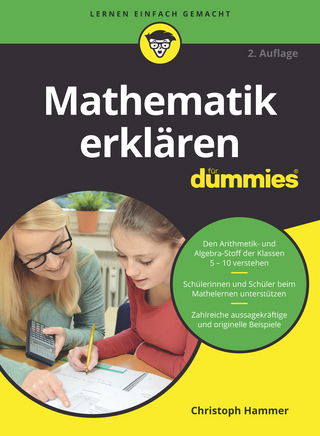
Convolutions in French Mathematics, 1800–1840
Springer Basel (Verlag)
978-3-7643-2240-3 (ISBN)
- Titel ist leider vergriffen;
keine Neuauflage - Artikel merken
Herausgegeben von: Hiebert, Erwin; Wussing, Hans;
1 Propaedeutic.- 1.1 Gobbets.- 1.2 Micropaedia.- 1.3 On the philosophy of mathematics.- 1.4 On the historiography of mathematics.- 1.5 On the organisation of the text.- 2 Institutions and individuals around the 1800s.- 2.1 Plan of the chapter.- 2.2 Research at the Institut and elsewhere.- 2.3 Education at the Ecole Polytechnique.- 2.4 Other schools, mostly in Paris.- 2.5 Major and minor figures.- 2.6 New men and a new profession.- 3 The 18th-century heritage: the calculus around 1800.- 3.1 Plan of the chapter.- 3.2 The foundations of the calculus in the late 18th century.- 3.3 On differential equations.- 3.4 On series, functions and integrals.- 3.5 On differences, interpolation and tables.- 3.6 Concluding comments: the aspirations of Lacroix 183.- 4 The Lagrangian tradition in the calculus, 1800–1815.- 4.1 Plan of the chapter.- 4.2 New figures, and a new journal.- 4.3 Consequences of Lagrange: functions and the new algebras.- 4.4 Differential and difference equations.- 4.5 On the calculus of variations.- 4.6 Equations and their roots.- 4.7 Case studies in the relationship between geometry and algebra.- 4.8 Concluding comments.- Interlude 480.1 The calculus outside France.- 5 The 18th-century heritage: mechanics around 1800.- 5.1 Prefaces.- 5.2 Principles and scope of mechanics in the late 18th century.- 5.3 Two main results, and their various proofs.- 5.4 On celestial mechanics.- 5.5 On planetary mechanics.- 5.6 Concluding comment: the aspirations of Laplace.- Interlude 525.1 Notes on handling differential models in mathematical physics.- 6 Progress in mechanics, 1800–1815.- 6.1 Prefaces.- 6.2 Research and education in terrestrial mechanics.- 6.3 Variational mechanics: the Poisson and Lagrange brackets, 1808–1810.- 6.4 Celestial and planetary mechanics—with statistics.- 6.5 Potential theory and the pendulum.- 6.6 Concluding comments.- Interlude 641.1 Notes on German theoretical astronomy.- Interlude 660.1 Mechanics outside France.- 7 Laplace’s mathematicised molecular physics, 1804–1816.- 7.1 Prefaces.- 7.2 The first steps.- 7.3 Poisson versus Germain on elastic surfaces, 1811–1815.- 7.4 On Laplacian optics.- 7.5 On Newtonian electricity and magnetism.- 7.6 Poisson’s inauguration of mathematical electrostatics, 1812–1813.- 7.7 Concluding comment: the aspirations of the Laplacians.- 8 Aspects of engineering mathematics, 1800–1816.- 8.1 Prefaces.- 8.2 Some principal figures and organisations.- 8.3 Perspectives on descriptive geometry.- 8.4 On the engineering science of materials.- 8.5 On the engineering studies of fluids.- 8.6 Concluding comment: the spectrum of engineering mathematics.- Interlude 860.1 On engineering outside France.- 9 The entry of Fourier: heat theory and Fourier analysis, 1800–1816.- 9.1 Prefaces.- 9.2 The diffusion equation and its series solutions.- 9.3 Reactions and further results, 1808–1815.- 9.4 Fourier’s prospects.- 9.5 Concluding comment: the aspirations of Fourier.- Interlude 934.1 Notes on the history of the Laplace transform.- 10 The entry of Cauchy: complex variables and differential equations, 1810–1822.- 10.1 Prefaces.- 10.2 Complex variables and the evaluation of integrals, 1810–1815.- 10.3 Poisson and Cauchy on the propagation of waves, 1815-1817.- 10.4 Competing solutions to linear partial differential equations, 1818-1822.- 10.5 Concluding comment: the aspirations of Cauchy.- 11 Cauchy’s inauguration of mathematical analysis, 1820–1827.- 11.1 Prefaces.- 11.2 On the general theory of partial differential equations to 1820.- 11.3 Cauchy on the primacy of limits: the Cours d’analyse, 1821.- 11.4 Integrals, real and complex, 1820–1823.- 11.5 Cauchy’s calculus, real and complex, 1823–1827.- 11.6 Miscellaneous studies of the mid 1820s.- 11.7 Concluding comments: the position of Cauchy.- Interlude 1170.1 Notes on mathematical analysis outside France.- 12 The consolidation of heat theory, 1816–1825.- 12.1 Plan of the chapter.- 12.2 New studies of the physics of heat.- 12.3 ‘Elastic fluids’ and the velocity of sound with Laplace and Poisson, 1816–1823.- 12.4 Planetary heat theory with Fourier and Laplace, 1817–1820.- 12.5 Heat diffusion and radiation with Poisson and Fourier, 1821 to 1825.- 12.6 Concluding comment: heat theory in textbooks and treatises.- 13 The entry of Fresnel: physical optics, 1815–1824.- 13.1 Prefaces.- 13.2 The battle over diffraction, 1815–1819.- 13.3 Fresnel’s developing theories, 1816–1821.- 13.4 The victory over double refraction, 1819–1822.- 13.5 The consolidation of Fresnel’s theory, 1822–1823.- 13.6 Concluding comments.- Interlude 1361.1 On Fresnel’s work on lighthouse lamps.- 14 The entry of physicist Ampère: electricity and magnetism, especially their connections, 1820–1826.- 14.1 Prefaces.- 14.2 Ampère’s first moves, 1820–1822.- 14.3 Ampère’s supporters, 1823.- 14.4 The consolidation of Ampère’s theory, 1824–1826.- 14.5 Poisson’s further studies of magnetism, 1825–1826.- 14.6 Concluding comments 965 14.6.1 The isolated achievements of Ampère and Poisson.- 14.6.2 Laplace on problems in physics, 1825.- 15 The entry of Navier and the triumph of Cauchy: elasticity theory, 1819–1830.- 15.1 Plan of the chapter.- 15.2 The entry of Navier.- 15.3 Navier’s applied elasticity theory, 1823–1826.- 15.4 Cauchy’s inauguration of linear elasticity theory, 1827–1829.- 15.5 Poisson’s molecular elasticity theory, 1827–1829.- 15.6 Extensions of elasticity theories, 1828–1830.- 15.7 Concluding comment: the theories of elasticity.- 16 Work for the workers: engineering mechanics and its instruction, 1800–1830.- 16.1 Prefaces.- 16.2 New figures and their institutions.- 16.3 Concepts of work from Euler to Navier.- 16.4 Coriolis and Poncelet on ‘work’ in mechanics, 1829.- 16.5 Contemporary case studies in the concept of work.- 16.6 Educating the workers in work.- 16.7 Concluding comments: the aspirations for work.- 17 Towards the 1830s: the new generation.- 17.1 Prefaces.- 17.2 Aspects of mathematical analysis.- 17.3 Aspects of algebra.- 17.4 Aspects of corporeal mechanics.- 17.5 Mostly heat theory.- 17.6 Aspects of celestial and planetary mechanics.- 17.7 Aspects of engineering and its economy.- 17.8 Concluding comments: a change of air.- Interlude 1754.1 Paris mathematics in Ohm and Green.- 18 Towards the 1840s: epilogue.- 18.1 Plan and purpose of the chapter.- 18.2 Into the 1830s.- 18.3 Coda: into the 1840s.- 19 Chorus.- 19.1 Plan of the chapter.- 19.2 The savants and their institutions.- 19.3 The savants and their community.- 19.4 The savants and their achievements.- 19.5 A self-appraisal: the desimpliflcation of history.- 19.6 Gobbets.- 20 Texts of selected manuscripts and printings.- 20.1 Letter from Biot to Lacroix, 1800 (?).- 20.2 Report to the Ecole Polytechnique by Lacroix, 1805.- 20.3 Draft letter from Lacroix to F. J. Français.- 20.4 Extracts of a letter from Duchayla to Poinsot, 1813.- 20.5 Changed passages in Fourier’s book on heat diffusion, 1822.- 20.6 Letter from Ampère to P. Erman, 1823.- 20.7 Selections from notes by Poncelet on mechanics, 1825.- 20.8 Selections from de Prony’s criticisms of Cauchy at the Ecole Polytechnique, 1826–1829.- 20.9 Changed passages in the preface of Coriolis’s book on mechanics, 1829.- 20.10 Selections from minutes of the Paris Faculté on Hachette’s successor, 1834.- 20.11 Selections from a report by Coriolis to the Ecole Polytechnique, 1840.- 21 Tables.- 21.1 Career details of the major figures.- 21.2 Personnel and students at the Ecole Polytechnique.- 21.3 Chronological summary.- 22 Bibliography.- 22.1 Order.- 22.2 References.- 22.3 Journals.- 22.4 Abbreviations.- 22.5 Items.- 23 Indexes.- 23.1 Explanatory introduction.- 23.2 Index of persons and their work.- 23.3 Index of institutions and publications.- 23.4 Index of subjects.
| Erscheint lt. Verlag | 1.1.1990 |
|---|---|
| Reihe/Serie | Science Networks. Historical Studies ; 2/3/4 |
| Zusatzinfo | 1602 p. 32 illus. |
| Verlagsort | Basel |
| Sprache | englisch |
| Gewicht | 3415 g |
| Themenwelt | Mathematik / Informatik ► Mathematik ► Allgemeines / Lexika |
| Mathematik / Informatik ► Mathematik ► Geschichte der Mathematik | |
| Schlagworte | Analysis • Hardcover, Softcover / Mathematik/Allgemeines, Lexika • HC/Mathematik/Allgemeines, Lexika • Mathematische Physik • Zykloide |
| ISBN-10 | 3-7643-2240-3 / 3764322403 |
| ISBN-13 | 978-3-7643-2240-3 / 9783764322403 |
| Zustand | Neuware |
| Haben Sie eine Frage zum Produkt? |
aus dem Bereich


